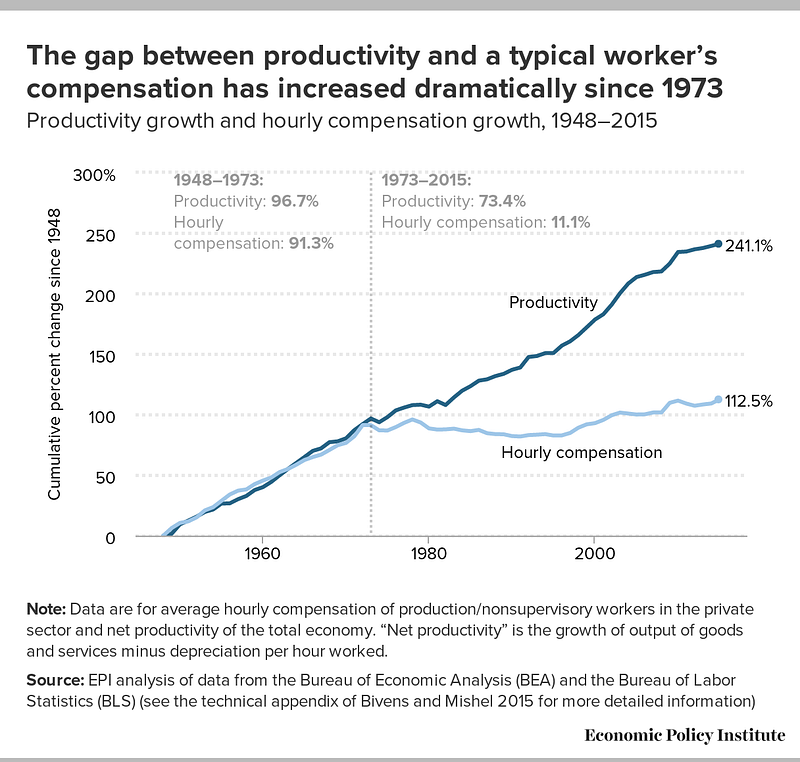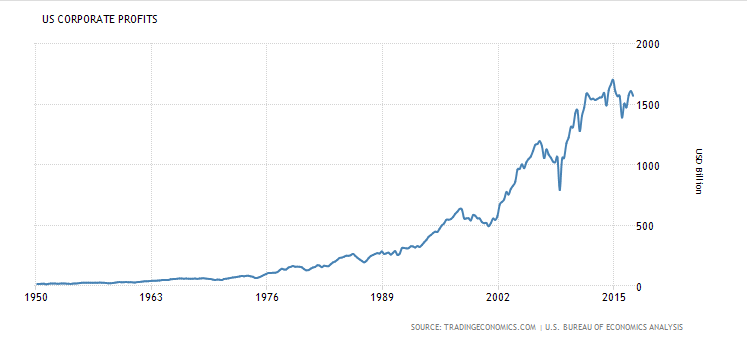“Goldman Sachs: Sobriety scares us.”
On May 26, 2017, Paul Constant writes on Civic Skunk Works:
In a private newsletter to wealthy investors, Goldman Sachs analysts warn that “rising wages are a threat to corporate profit margins.”
On Tuesday May 23rd, investment firm Goldman Sachs sent an edition of their Global Markets Daily e-newsletter to customers. It’s the kind of email that goes out to high-rollers and high-stakes investors—the big shots who will gladly chase profits across international boundaries. The newsletter contains a combination of investment news — in this case a couple of bullet points about Chinese industrial production and OPEC’s quest for stability — and analysis for investors in the global marketplace.
Global Markets Daily is apparently not available online unless you’re a Goldman Sachs customer, but Civic Ventures obtained a copy after Luke Kawa published a piece of it in Bloomberg. Specifically, we’re interested in the second item in the newsletter, which is written by Goldman strategists Charles P. Himmelberg and James Weldon. It’s titled “What Happens to Profits if Wages Catch up with Productivity?” and it begins with some unequivocally good news.
“Wages are rising. The ‘wage tracker’ maintained by our US economics team — a composite measure of wage growth based on the four main wage indicators — hit 3.0% year-on-year in the first quarter for the first time in this expansion.”
Fantastic! Worker wages have been flat in the United States for almost the entire 21st century. If more workers have more money, surely they’ll spend it, thereby supercharging the economy with their increased demand. Good news for Goldman Sachs investors, right?
Apparently not. Here’s the very next sentence, with emphasis added:
“And as our colleagues in equity strategy have recently pointed out, rising wages are a threat to corporate profit margins (“Labor Costs and US Equities: Stocks Confront Rising Wages with Economy at Full Employment”, Portfolio Strategy Research, May 9, 2017).”
A “threat?” How can that be? Weldon and Himmelberg explain that worker productivity is growing, too, but it’s not likely to grow at pace with wages. “More importantly for profits,” they write…
“…it seems highly unlikely that labor productivity will keep pace with wage growth. On the contrary, with labor markets already tight and likely to tighten further, and wages already growing at 3%yoy, odds are strong that wage growth will continue, while the outlook for productivity growth remains far less certain.
“With this backdrop in mind, we ask: What would happen to US corporate profits if real wages were to catch up with average labor productivity?”
The most important words in that last paragraph are “catch up.” See, labor productivity in the United States has long been divorced from wage growth. The Economic Policy Institute says the gap erupted in 1973 and has been widening ever since, as shown in this graph:

Put simply, this means that for the last 40 years, when you’ve been working harder, you’ve been paid less. (And make no mistake: we do work harder and longer than anyone in the world, putting in “137 more hours per year than Japanese workers, 260 more hours per year than British workers, and 499 more hours per year than French workers.”) In the note, Weldon and Himmelberg even refer to this “opening of the gap” between wages and productivity as “extreme” and “unprecedented.”
Recently — thanks in part to the $15 minimum-wage movement — wages and productivity have started to converge again. Your paycheck has finally started to represent the real value of your work.
Seems like a good thing, right? Not for Goldman Sachs. In their newsletter, Himmelberg and Weldon played out what might happen if American workers started to get paid what they’re worth again—specifically, “a decline in the annualized 5-year growth rate of corporate profit margins of roughly 10% by 2020.”
Please bear in mind that Weldon and Himmelberg aren’t calling your wages “a threat” to the survival of corporations. They’re not even “a threat” to corporate revenue. No, the “threat” that they’re predicting is a ten percent decrease in corporate profits.
For reference, here’s a chart showing US corporate profits since 1950:

Corporate profits in the United States fell by $40.3 billion, or 2.5 percent, to $1571.2 billion in the first quarter…tradingeconomics.com
So corporate profit has been spiking for forty years while the schism between productivity and wages has widened into a Grand Canyon. Anyone who can read a chart can see that these trends are unsustainable.
What do Goldman’s experts think the cause of the worker wage-productivity gap could be? Why haven’t workers been paid what they’re worth? Well, Himmelberg and Weldon don’t have the faintest clue:
“Our scenario analysis declines to address the economics of the question, namely, why aren’t markets equating real wages with average labor productivity? We suspect the answer has much to do with changes in market power over time (which may or may not be reversing).”
Dig those weasel words: “suspect,” “may or may not be,” “declines to address.” Could it be that worker wages became so divorced from productivity not because of some mysterious market forces, but because corporate bosses just declined to give their workers raises and kept the money for themselves?
Could it be that the outrageous profits enjoyed by Goldman Sachs investors are way too high, and that investors and CEOs have over time transferred a larger and larger share of worker pay to their own bottom line?
Could your wages possibly be so low because those in power prioritize shareholder profit maximization above all else? Can we truly say we live in an advanced economy when the moneyed few who subscribe to a Goldman Sachs e-newsletter profit on the relentless exploitation of millions of American workers?
Does Goldman Sachs value a small sliver of profit over the opportunity to create a sustainable economy that works for everyone?
Seems pretty likely to me. Especially since Weldon and Himmelberg spend the first half of the note bellyaching over a possible ten percent decline in corporate profits if wages and productivity begin to match up again.
The final sentence of their note, to me, is when the whole damn thing tips over into being flat-out bonkers:
“In the meantime, we find the prospect of what a normalization would look like to be sobering.”
Himmelberg and Weldon admit that increased wages for American workers represents “normalization.” It’s how things should be. But they call the very idea of a normalization “sobering.”
That phrasing is so telling. Think about this for a moment. Who needs sobering? Someone who’s really drunk. Someone who maybe ate a little bit too much of that pot brownie. Someone who’s out of control.
And what Goldman Sachs analysts find “sobering” is the idea of a job market doing what it should do. The very thought of losing ten percent of their outsized annual profits to what they admit would be a properly functioning job market is “sobering.”
And that’s not even the dumbest part of all this! Himmelberg and Weldon are forgetting a very important part of this model. They’re treating this trade between profits and wages like it’s a zer0-sum game—that investors have to lose when workers win. That’s not the case at all.
What Weldon and Himmelberg fail to understand, of course, is that when workers get paid, that money doesn’t disappear. Workers are much more likely to spend their money than, say, CEOs (who, according to the Economic Policy Institute, on average “make over 300 times what typical workers earn”) or corporations. By raising worker wages,we are investing in the economy — increasing consumer spending and creating more jobs with that demand.
Goldman Sachs employees seem to have come to believe the hype perpetuated by the Republican Party communications apparatus—the flatly false claim that it is Wall Street and investors who are the true job creators. In fact, it is and has always been the American middle class who create the demand. Their spending, and not corporate profits, is what grows the economy.
Goldman Sachs is wrong to believe that a raise for the working class is a “threat.” In fact, the real threat to America’s economy comes from the indefensibly enormous corporate profits that Goldman Sachs analysts are so eager to protect.
This article is written from a one-factor labor worker point of view.
Binary economist Louis Kelso stated: “The myth of the ‘rising productivity’ of labor is used to conceal the increasing productiveness of capital and the decreasing productiveness of labor, and to disguise income redistribution by making it seem morally acceptable.”
Kelso argued that unions “must adopt a sound strategy that conforms to the economic facts of life. If under free-market conditions, 90 percent of the goods and services are produced by capital input, then 90 percent of the earnings of working people must flow to them as wages of their capital and the remainder as wages of their labor work… If there are in reality two ways for people to participate in production and earn income, then tomorrow’s producers’ union must take cognizance of both… The question is only whether the labor union will help lead this movement or, refusing to learn, to change, and to innovate, become irrelevant.”
To comprehend what Kelso was referring to one must recognize that there are two independent factors of production: humans (labor workers who contribute manual, intellectual, creative and entrepreneurial work) and non-human capital (land; structures; infrastructure; tools; machines; robotics; computer processing; certain intangibles that have the characteristics of property, such as patents and trade or firm names; and the like which are owned by people individually or in association with others). Fundamentally, economic value is created through human and non-human contributions.
The role of physical productive capital is to do ever more of the work, which produces wealth and thus income to those who own productive capital assets. Full employment is not an objective of businesses. Companies strive to keep labor input and other costs at a minimum in order to maximize profits for the owners. They strive to minimize marginal costs, the cost of producing an additional unit of a good, product or service once a business has its fixed costs in place, in order to stay competitive with other companies racing to stay competitive through technological innovation. Reducing marginal costs enables businesses to increase profits, offer goods, products and services at a lower price (which people as consumers seek), or both. Increasingly, new technologies are enabling companies to achieve near-zero cost growth without having to hire people. Thus, private sector job creation in numbers that match the pool of people willing and able to work is constantly being eroded by physical productive capital’s ever increasing role.
The result is that the price of products and services are extremely competitive as consumers will always seek the lowest cost/quality/performance alternative, and thus for-profit companies are constantly competing with each other (on a local, national and global scale) for attracting “customers with money” to purchase their products or services in order to generate profits and thus return on investment (ROI).
Over the past century there has been an ever-accelerating shift to productive capital — which reflects tectonic shifts in the technologies of production. The mixture of labor worker input and capital worker input has been rapidly changing at an exponential rate of increase for over 239 years in step with the Industrial Revolution (starting in 1776) and had even been changing long before that with man’s discovery of the first tools, but at a much slower rate. Up until the close of the nineteenth century, the United States remained a working democracy, with the production of products and services dependent on labor worker input. When the American Industrial Revolution began and subsequent technological advances amplified the productive power of non-human capital, plutocratic finance channeled its ownership into fewer and fewer hands, as we continue to witness today with government by the wealthy evidenced at all levels.
People invented “tools” to reduce toil, enable otherwise impossible production, create new highly automated industries, and significantly change the way in which products and services are produced from labor intensive to capital intensive — the core function of technological invention and innovation. Kelso attributed most changes in the productive capacity of the world since the beginning of the Industrial Revolution to technological improvements in our capital assets, and a relatively diminishing proportion to human labor. Capital, in Kelso’s terms, does not “enhance” labor productivity (labor’s ability to produce economic goods). In fact, the opposite is true. It makes many forms of labor unnecessary. Because of this undeniable fact, Kelso asserted that, “free-market forces no longer establish the ‘value’ of labor. Instead, the price of labor is artificially elevated by government through minimum wage legislation, overtime laws, and collective bargaining legislation or by government employment and government subsidization of private employment solely to increase consumer income.”
Furthermore, according to Kelso, productive capital is increasingly the source of the world’s economic growth and, therefore, should become the source of added property ownership incomes for all. Kelso postulated that if both labor and capital are independent factors of production, and if capital’s proportionate contributions are increasing relative to that of labor, then equality of opportunity and economic justice demands that the right to property (and access to the means of acquiring and possessing property) must in justice be extended to all. Yet, sadly, the American people and its leaders still pretend to believe that labor is becoming more productive, and ignore the necessity to broaden personal ownership of wealth-creating, income-producing capital assets simultaneously with the growth of the economy.
It is the exponential disassociation of production and consumption that is the problem in the United States economy, and the reason that ordinary citizens must gain access to productive capital ownership to improve their economic well-being.
Kelso postulated: “When consumer earning power is systematically acquired in the course of the normal operations of the economy by people who need and want more consumer goods and services, the production of goods and services should rise to unprecedented levels; the quality and craftsmanship of goods and services, freed of the corner-cutting imposed by the chronic shortage of consumer purchasing power, should return to their former high levels; competition should be brisk; and the purchasing power of money should remain stable year after year.”
Without this necessary balance hopeless poverty, social alienation, and economic breakdown will persist, even though the American economy is ripe with the physical, technical, managerial, and engineering prerequisites for improving the lives of the 99 percent majority. Why? Because there is a crippling organizational malfunction that prevents making full use of the technological prowess that we have developed. The system does not fully facilitate connecting the majority of citizens, who have unsatisfied needs and wants, to the productive capital assets enabling productive efficiency and economic growth.
Kelso said, “We are a nation of industrial sharecroppers who work for somebody else and have no other source of income. If a man owns something that will produce a second income, he’ll be a better customer for the things that American industry produces. But the problem is how to get the working man [and woman] that second income.”


